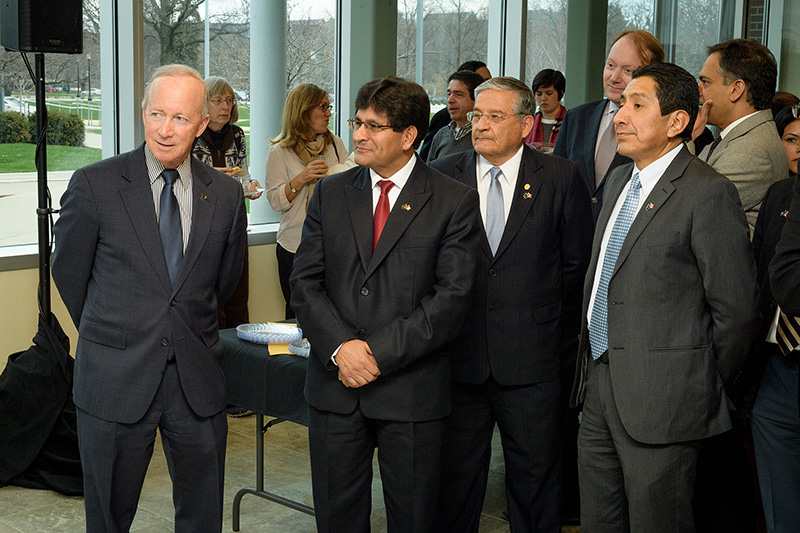Past News
Analysis: Most microplastic harm done at lowest levels of food web

April 30, 2018
Microplastics, bits of plastics that have found their way into waters in and around every continent on Earth, have a range of impacts on aquatic life, according to a meta-analysis led by Purdue University’s Tomas Höök. Most negatively affected are zooplankton and larval fish.
Read More about "Analysis: Most microplastic harm done at lowest levels of food web"
Far-red fluorescent silk can kill harmful bacteria as biomedical and environmental remedy

April 18, 2018
A silk hybrid material attacks bacteria when illuminated by a green light, thanks to a far-red fluorescent protein researchers transferred to its genetic makeup.
Critical Transition in Critical Zone of Intensively Managed Landscapes
April 17, 2018
Expansion and intensification of managed landscapes for agriculture have resulted in severe unintended global impacts, including degradation of arable land and eutrophication of receiving water bodies. Modern agricultural practices rely on significant direct and indirect human energy inputs through farm machinery and chemical use, respectively, which have created imbalances between increased rates of biogeochemical processes related to production and background rates of natural processes.
Critical Transition in Critical Zone of Intensively Managed Landscapes
Evidence that an informal environmental summer camp can contribute to the construction of the conceptual understanding and situational interest of STEM in middle-school youth
April 13, 2018
Youth are introduced to STEM topics through informal settings like science camps, aquaria, and zoos. In these interactive and sensory-rich environments, a well-designed programme can help participants to acquire knowledge and cultivate interest through experiential learning. Given the importance of informal activities in environmental education, it is crucial to identify which contextual components lead to successful learning outcomes. Thus far, research in environmental STEM education has focused on brief experiences, such as one-time visits to curated environments likeaquaria. Investigating the impact of multi-day/longer experiences in natural settings is critical because the level of engagement with the STEM topic and the interaction with the learning environment in such experiences have different cognitive and affective impacts. To address these current limitations, we explored whether there is evidence that a four-day, immersive outdoor soundscape ecology camp contributed to situational interest and conceptual understanding of middle-school youth.
Evidence that an informal environmental summer camp can contribute to the construction of the conceptual understanding and situational interest of STEM in middle-school youth
Purdue, Peruvian university kick off research and innovation alliance

April 9, 2018
Purdue University celebrated the official start of its new Cooperative Technical Alliance Program with the Universidad Nacional de San Agustin (UNSA) with the launch of its initial flagship research and capacity building initiative: the Arequipa Nexus Institute for Food, Water, Energy, and the Environment. The celebration took place Monday (April 9) at Purdue. “Purdue is a leader in developing holistic approaches to global sustainability grand challenges based on partnerships,” said Tomás Díaz De La Rubia, chief scientist and executive director of Purdue’s Discovery Park. “Through a close collaboration with our partners at UNSA, Discovery Park can bring the full power of its unique interdisciplinary approach to improve the lives of the citizens of Arequipa through the application of our leading-edge expertise to the regional sustainable development challenges. The partnership represents a new paradigm in the development and application of scientific and socio-economic approaches to global sustainability grand challenges, and we fully expect to expand this new paradigm to new relationships in other regions of Peru and Latin America in the future.”
Read More about "Purdue, Peruvian university kick off research and innovation alliance"
Recent paper describes summertime diurnal variations in the isotopic composition of atmospheric nitrogen dioxide in West Lafayette
April 6, 2018
The nitrogen and oxygen stable isotopes (?15N & ?18O) of nitrogen oxides (NOx = nitric oxide (NO) + nitrogen dioxide (NO2)) may be a useful tool for partitioning NOx emission sources and for evaluating NOx photochemical cycling, but few measurements of in situ NOx exist. In this study, we have collected and characterized the diurnal variability in ?15N and ?18O of NO2 from ambient air at a small Midwestern city (West Lafayette, IN, USA, 40.426° N, 86.908° W) between July 7 to August 5, 2016, using an active sampling technique. Large variations were observed in both ?15N(NO2) and ?18O(NO2) that ranged from ?31.4 to 0.4‰ and 41.5–112.5‰, respectively.
Recent paper describes summertime diurnal variations in the isotopic composition of atmospheric nitrogen dioxide in West Lafayette
Purdue Pugwash conference to focus on climate and society
April 5, 2018
The 2018 Purdue Student Pugwash Midwest Regional Conference will examine the social and ethical dimensions relating to climate change and society. The two-day conference, titled “Climate Change: How to Sustain our Future,” will open at 6 p.m. on April 13 in Purdue Memorial Union West Faculty Lounge. Registration will begin at 5:30 p.m. On April 14, the conference will continue at 8:30 a.m. in Stewart Center, Room 279. Winona LaDuke, Native American environmentalist and political activist, will be the keynote speaker. Other speakers include Jeffrey Dukes, director of Purdue Climate Change Research Center and professor of forestry and natural resources and biological sciences, and Manjana Milkoreit, a Purdue assistant professor of political science.
Prevention of Elevated Blood Lead Levels Among Child Refugees and Other Susceptible Populations
March 30, 2018
The toxicity of lead and its effects on child neurodevelopment have been well documented for decades. The dramatic decrease in average blood lead levels in the United States over the past several decades is an undeniable public health achievement. Over the same period it has been recognized that, unfortunately, there is no safe level of lead exposure. The continued presence of lead in water pipes, paint, and soils results in continued elevated blood lead levels (EBLLs) among children, particularly those of lower socioeconomic status. Globally, many nations are still using lead in industrial processes, gasoline, paint, or consumer products. Thus, lead exposure remains an important health concern in the United States and globally.
Prevention of Elevated Blood Lead Levels Among Child Refugees and Other Susceptible Populations
Weather Generator Effectiveness in Capturing Climate Extremes
March 27, 2018
Weather generators are increasingly used in environmental, water resources, and agricultural applications. Given their potential, it is important that weather generators be evaluated, particularly with respect to their ability to capture extreme events. This study was aimed at evaluating weather generator representation of climate extremes with a focus on LARS-WG applied to three stations in the Western Lake Erie Basin, U.S. Generally, LARS-WG captured the number of days with precipitation greater than 50.8 mm (2 in. and 101.6 mm (4 in), 7-day wet sequences, and wet and dry sequences relatively well.
Weather Generator Effectiveness in Capturing Climate Extremes
Position Announcement: Director, Center for the Environment, Discovery Park, Purdue University
March 23, 2018
Purdue University seeks an individual with vision and demonstrated leadership skills to guide an innovative team of scholars as the Director of the Center for the Environment in Discovery Park on the West Lafayette, Indiana campus.
